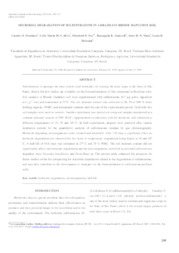Microbial degradation of sulfentrazone in a Brazilian Rhodic Hapludox soil.
Microbial degradation of sulfentrazone in a Brazilian Rhodic Hapludox soil.
Author(s): MARTINEZ, C. O.; SILVA, C. M. M. de S.; FAY, E. F.; ABAKERLI, R. B.; MAIA, A. de H. N.; DURRANT, L. R.
Summary: Sulfentrazone is amongst the most widely used herbicides for treating the main crops in the State of São Paulo, Brazil, but few studies are available on the biotransformation of this compound in Brazilian soils. Soil samples of Rhodic Hapludox soil were supplemented with sulfentrazone (0.7 µg active ingredient (a.i.) g-1 soil) and maintained at 27ºC. The soil moisture content was corrected to 30, 70 or 100 % water holding capacity (WHC) and maintained constant until the end of the experimental period. Herbicide-free soil samples were used as controls. Another experiment was carried out using soil samples maintained at a constant moisture content of 70% WHC, supplemented or otherwise with the herbicide, and submitted to different temperatures of 15, 30 and 40º C. In both experiments, aliquots were removed after various incubation periods for the quantitative analysis of sulfentrazone residues by gas chromatography. Herbicide-degrading microorganisms were isolated and identified. After 120 days a significant effect on herbicide degradation was observed for the factor of temperature, degradation being higher at 30 and 40º C. A half-life of 91.6 days was estimated at 27º C and 70 % WHC. The soil moisture content did not significantly affect sulfentrazone degradation and the microorganisms identified as potential sulfentrazone degraders were Nocardia brasiliensis and Penicillium sp. The present study enhanced the prospects for future studies on the bio-prospecting for microbial populations related to the degradation of sulfentrazone, and may also contribute to the development of strategies for the bioremediation of sulfentrazone-polluted soils.
Publication year: 2010
Types of publication: Journal article
Unit: Embrapa Environment
Keywords: Biodegradação
Observation
Some of Embrapa's publications are published as ePub files. To read them, use or download one of the following free software options to your computer or mobile device. Android: Google Play Books; IOS: iBooks; Windows and Linux: Calibre.
Access other publications
Access the Agricultural Research Database (BDPA) to consult Embrapa's full library collection and records.
Visit Embrapa Bookstore to purchase books and other publications sold by Embrapa.

